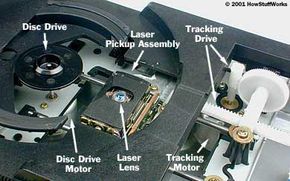Optical Storage
The optical storage device that most of us are familiar with is thecompact disc(CD). A CD can store huge amounts of digital information (783 MB) on a very small surface that is incredibly inexpensive to manufacture. The design that makes this possible is a simple one: The CD surface is a mirror covered with billions of tiny bumps that are arranged in a long, tightly wound spiral. The CD player reads the bumps with a precise laser and interprets the information as bits of data.
The spiral of bumps on a CD starts in the center. CD tracks are so small that they have to be measured inmicrons(millionths of a meter). The CD track is approximately 0.5 microns wide, with 1.6 microns separating one track from the next. The elongated bumps are each 0.5 microns wide, a minimum of 0.83 microns long and 125nanometers(billionths of a meter) high.
Advertisement
大部分的CD是一个射出成型的质量πece of clear polycarbonate plastic that is about 1.2 millimeters thick. During manufacturing, this plastic is impressed with the microscopic bumps that make up the long, spiral track. A thin, reflective aluminum layer is then coated on the top of the disc, covering the bumps. The tricky part of CD technology is reading all the tiny bumps correctly, in the right order and at the right speed. To do all of this, the CD player has to be exceptionally precise when it focuses the laser on the track of bumps.
When you play a CD, the laser beam passes through the CD's polycarbonate layer, reflects off the aluminum layer and hits an optoelectronic device that detects changes in light. The bumps reflect light differently than the flat parts of the aluminum layer, which are calledlands. The optoelectronic sensor detects these changes in reflectivity, and the electronics in the CD-player drive interpret the changes as data bits.



